7 Settings That Slow Down Your Android Phone
Even if your Android phone has impressive specs, it won't always perform at its best. The culprit is often not the hardware, but the way it's configured.
7. Adaptive Battery
Android's Adaptive Battery feature is designed to help extend your phone's battery life by learning which apps you use most often and limiting background activity for apps you rarely use. In theory, it's a great way to save battery while optimizing overall performance.
However, Adaptive Battery can also slow things down at times. Because it limits background processes, some of your apps may take longer to load, and you may even experience delays in receiving notifications from those apps.
If your Android phone has a large battery and supports fast charging, the benefits of Adaptive Battery may not outweigh the disadvantages. In that case, it's best to turn off Adaptive Battery.
To do this, go to Settings > Battery > Adaptive preferences and turn off the Adaptive Battery toggle . If you have a Samsung phone, go to Settings > Battery > Background usage limits . Then, tap the three-dot menu, select Adaptive Battery , and turn off the toggle.
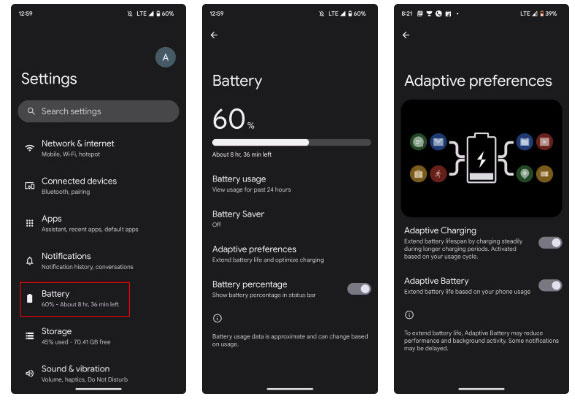
6. RAM Plus or RAM Boost
RAM Plus (or RAM Boost) is a feature that promises to boost performance by using a portion of your phone's internal memory as virtual RAM. In theory, this seems like an effective way to improve performance, especially on phones with limited physical memory. However, the reality is a bit more complicated.
However, unlike RAM , your phone's internal memory is much slower. So when your device relies heavily on this virtual memory, performance can suffer. Switching between apps can become slow, loading times can increase, and background apps often reload instead of resuming immediately.
If your device has 8GB or more of RAM, enabling RAM Plus or RAM Booster may do more harm than good. To disable it on a Samsung phone, go to Settings > Battery & Device care > Memory > RAM Plus , then turn off the toggle. On other Android phones, you can disable it by simply searching for 'RAM Plus' or 'RAM Booster' in the Settings menu.
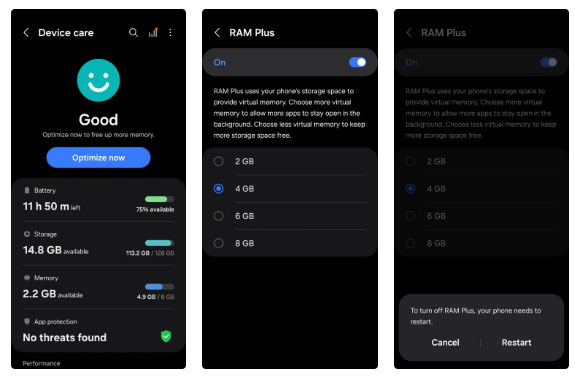
5. Change processing speed
Most Android phones have the option to switch between different performance modes. For example, Samsung phones often set the processor speed to "Optimized ." This mode balances performance, battery efficiency, and heat management, so your phone runs smoothly without draining the battery too quickly or overheating.
While the optimized settings generally work well, they're not ideal for running intensive apps or games. If your Android phone is feeling slow or laggy, it's best to switch to a higher performance mode. On Samsung phones, you can change the processing speed by navigating to Settings > Device care > Processing speed and selecting High or Maximum for better performance.
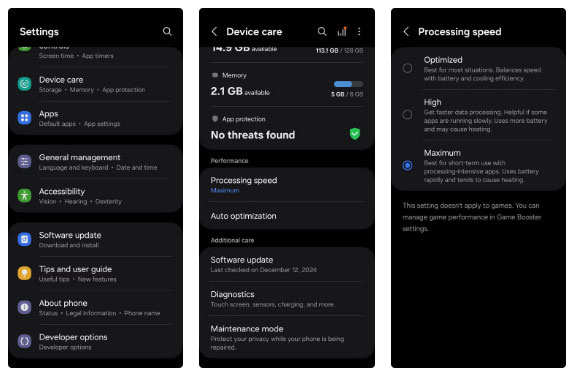
Other Android devices offer similar performance modes, although the exact location of the setting may vary. You can usually find them by searching for 'performance mode' or 'processing speed' in the Settings menu.
4. Background application activity
Your Android phone probably has dozens of apps installed, many of which are probably running in the background to sync data. While some apps need to run in the background for legitimate reasons, like syncing or receiving notifications, having too many apps running at once can be a problem. After all, you don't want your rarely used apps hogging your phone's resources when you're not using them.
You can easily identify apps that are running in the background by checking your phone's battery usage. Once identified, you can prevent these apps from running in the background by limiting their battery usage. Limiting or disabling background activity not only improves performance but also helps extend the battery life of your phone .
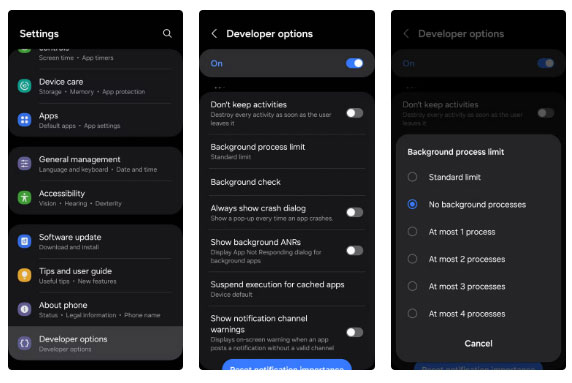
3. Auto sync for accounts
By default, when you add accounts to your Android phone, your device automatically turns on background sync for those accounts. This ensures that your contacts, emails, calendar events, and other essential information are always up to date on all your devices.
While this is convenient, it can also put unnecessary strain on your phone's resources, especially if you have multiple accounts that are constantly syncing. Your phone uses processing power and network bandwidth to keep up with data, and the more accounts you have, the more your device has to work in the background.
If your phone seems sluggish, you may want to check to see if all of your accounts need to sync regularly. To manage this, go to Settings > Accounts and backup > Manage accounts . From there, go through each account and turn off syncing for the ones you don't use often.
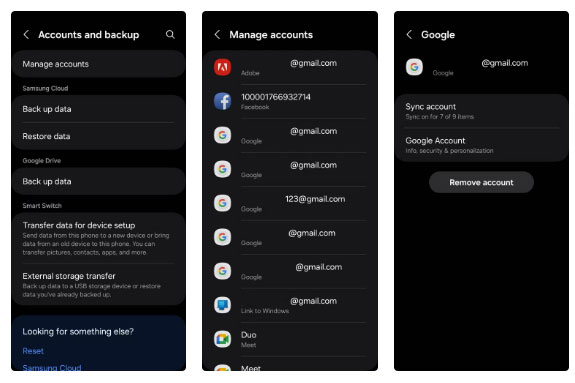
2. 1x animation ratio
Android phones are full of subtle animations that play when you open apps, navigate menus, or switch between screens. While these animations add visual appeal, they can also slow down your Android phone, especially if it's older.
By default, Android phones play all of these animations at 1x. Reducing the animation scale or turning it off altogether can help your phone run faster by reducing the time it takes to load and switch between apps or screens. This is the most effective way to make any old Android phone run like new .
To do this, you first need to enable the Developer Options menu on your Android phone. To do this, go to Settings > About > Software information and quickly tap Build number 7 times. Then, enter your PIN to enable the Developer Options menu.
Once enabled, go to Settings > Developer options and adjust Window animation scale , Transition animation scale , and Animator duration scale . You can set each option to .5x to make animations faster or Off to turn them off.
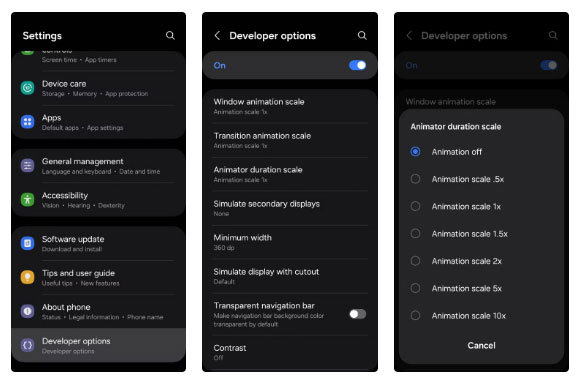
1. Background Processes Limit
Android phones are designed for multitasking, allowing you to run multiple apps at once in the background. Android's "Background Processes Limit" plays an important role in how well your phone handles multitasking.
By default, Android allows many apps to run in the background, which can consume valuable system resources like memory (RAM) and processing power. While this may not be a problem on high-end devices with plenty of resources, it can lead to sluggish performance on low-end or older models.
If you have too many apps running in the background, your device may have trouble loading new apps, experience significant lag, or even freeze temporarily. The "Background Processes Limit" setting can help you adjust how many processes are allowed to run in the background at any given time.
This option is also part of the hidden Developer Options menu, so make sure it's enabled. Then go to Settings > Developer options > Background processes limit and set it to 1, 2, 3, 4, or no background processes at all.
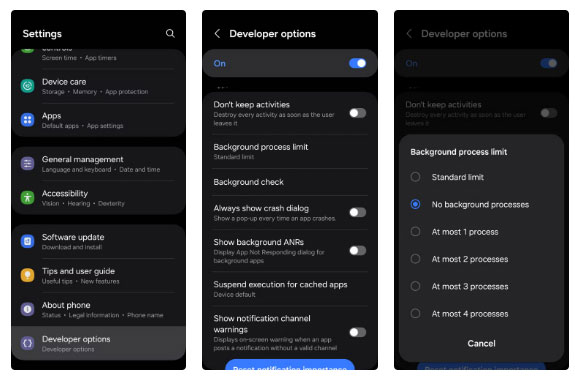
Note : Limiting too many background processes may affect notifications or apps that require continuous background activity, like music streaming or chat apps. So if you're having trouble, it's best to change this setting to "Standard limit".
While any one of these changes may not magically make your Android phone faster, all of them combined can make for noticeable improvements. They all help optimize your phone to run smoother.
And don't forget, the basics still matter: Regularly clearing memory, installing software updates, and regularly checking for malware are crucial to maintaining long-term speed and functionality.
You should read it
- Instructions to reset Android phone to restore factory settings
- Check Android phone configuration
- Why Some People Never Buy an Android Phone
- Instructions from AZ how to block calls and messages on Android Nougat
- List of devices to be Android 8 - Android O of Samsung, Huawei, LG, Oppo, Sony and HTC
- How to create slow motion videos on Android?
 These Android Apps Could Put Your Passwords at Risk If You're Not Careful
These Android Apps Could Put Your Passwords at Risk If You're Not Careful 8 Secure Folder tips Samsung Galaxy users should know
8 Secure Folder tips Samsung Galaxy users should know How to put apps to sleep on Samsung phones to save battery
How to put apps to sleep on Samsung phones to save battery How to Use Chrome to Easily View PDFs on Android
How to Use Chrome to Easily View PDFs on Android Why should fast charging be prioritized over battery capacity?
Why should fast charging be prioritized over battery capacity? How to group app notifications on iPhone
How to group app notifications on iPhone